Certain herbs and vegetables build delicious flavors in our favorite dishes! Plant-based foods that create a strong, savory flavor when cooked or crushed are often referred to as aromatics.
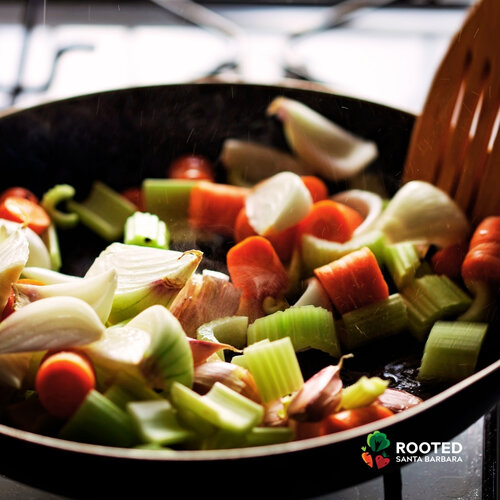 This may sound fancy, but we know these herbs and veggies as the foods that can make your eyes water and fill your kitchen with mouth-watering smells. Aromatics get the party started! Here are a few common aromatic ingredients:
This may sound fancy, but we know these herbs and veggies as the foods that can make your eyes water and fill your kitchen with mouth-watering smells. Aromatics get the party started! Here are a few common aromatic ingredients:
- garlic
- onions and leeks
- carrots
- celery
- ginger
- fennel
- many herbs and spices
“Humble Beginnings”
Did you know that aromatic vegetables and herbs have been used for centuries by people all over the world to create flavorful meals? Here’s how:
- In French cooking, Mirepoix (meer-pwah) is the foundation of many meals with equal amounts of finely chopped carrots, celery and onions.
- In Italy, this same combination is the first step for many dishes but is called Soffritto.
- Spanish recipes are likely to start with Sofrito, which is onion, garlic and tomatoes.
- Germany has Suppengrün, which is carrot, celeriac, and leeks.
- Cajun recipes often begin with the Holy Trinity of onion, celery, and green bell peppers.
- Puerto Rican dishes often start with Recaíto or Blessed Thistle, which is cilantro, ajices dulces chilies, onion, and garlic.
These savory combinations are often called “humble beginnings,” as they are simple ways to build delicious flavor in ways shared throughout the world.
The Flavor Builders
Here’s a deep dive into seven of our favorite aromatics for delicious, flavorful, and healthy meals:
Garlic
Garlic has long been used in culinary medicine to increase circulation, decongest the respiratory system, and as a general immune booster. Ancient Greeks used it to strengthen their athletes and soldiers and in certain circles it’s known as both Russian Penicillin or my personal favorite, Vegetable Viagra! As cooking does reduce many of its potent health benefits – but not its flavor – we try to add garlic as late in the cooking process as your taste buds can handle.
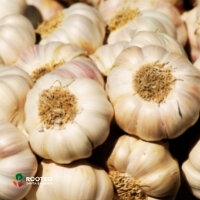
Pro-tip: Chop & Stop! When getting ready to cook – chop or crush your garlic first and let it sit for 10-15 minutes before you cook it. According to the American Institute for Cancer Research, this activates garlic’s natural cancer fighting components.
Celery
Like carrots and parsley, celery is a member of the umbellifer family. Its naturally salty flavor, but low sodium content, makes it a great addition for most dishes but it’s also loaded with Vitamin K – one stalk provides approximately 25% of your RDA. Vitamin K is known to keep our bones healthy and aids the body in wound healing and blood clotting.

Ginger
This knobby root has helped many upset stomachs. It is found in many Asian recipes for its mild and warming flavor that elevates both savory and sweet dishes. Ginger has been used for thousands of years to enhance immunity and as an anti-inflammatory. A few thin slices of ginger root in a mug of hot water is a great remedy for over-indulgence.
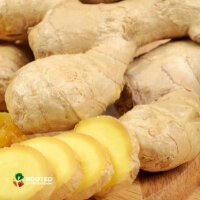
Leeks
Mostly known for its supporting role in leek and potato soup, these mild onions are a great source of inulin which our good gut bacteria thrive on. Leeks are believed to boost cardiovascular health due to a particular flavonoid they contain that is believed to “relax” our blood vessels which helps protect the vessel linings from damage.
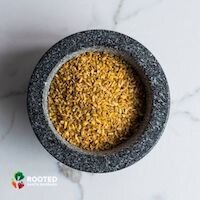
Carrots
Carrots are rich in carotenoids, the red and yellow pigments that are high in antioxidants.
We’ve always heard how good carrots are for our eyesight but carrots are also believed to assist in repairing cell damage.
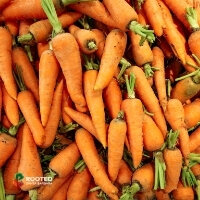
Fennel
You may not like fennel if you don’t enjoy the flavor of licorice, but its health benefits are undeniable. Loaded with phytonutrients many believe to be cancer fighting and inflammation reducing. Fennel features predominantly in both Greek and Roman mythology and was revered by both for its culinary and medicinal properties.
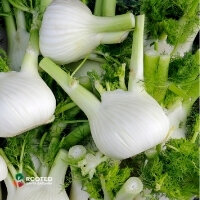
Starting Your Meals with Aromatics
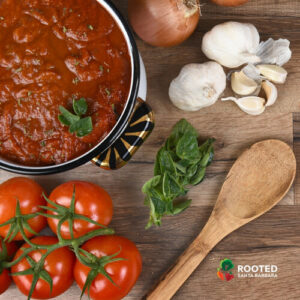 Aromatics are helpful and healthful and are often the reason someone may say “Wow, that smells great!” when they walk into your kitchen. These ingredients can be used when starting any meal, including:
Aromatics are helpful and healthful and are often the reason someone may say “Wow, that smells great!” when they walk into your kitchen. These ingredients can be used when starting any meal, including:
-
- soups or broths
- curries
- rice or noodle dishes
- beans
- stir-fries
- sauces
- sautéd or roasted veggies
- our favorite, tofu scramble!
Here’s How to Build Flavor with Aromatics in Your Kitchen
- Pour a thin layer of water or vegetable broth into your pan and be sure to watch the cooking temperature closely and stir regularly to keep the ingredients moving in the pan.
- If browning begins to occur, a tiny splash of water or veggie broth will take care of that until you’re ready to add your other ingredients.
- Cook each of your herbs and veggies and your aromatics separately at first to allow their powerful flavors to come to life. Starting with these simple ingredients can be really helpful when trying to limit fat, sugar, or salt since they are so flavorful.
- If the ingredient is available fresh that is best, but frozen or dried are great, too!
We believe that variety is key and when we include a wide variety of vibrant and nutrient-rich foods, all of our systems and cells are treated with the incredible power of plants! Cooking with aromatics is a simple and inexpensive way to bring both a range of health perks and wonderful variety, flavors, textures and scents to everyday meals.
Pro-tip: Save all of the scrap ends from your aromatic veggies in a container in the freezer for when you want to make your own veggie broth. Throw into a pot with water and simmer for a few hours for delicious, nutrient-rich, “free” broth. Don’t let that stuff go to waste!!
Emma Malina is a plant-based nutrition educator and food-skills instructor based in Santa Barbara, CA who empowers individuals and families worldwide to optimize their health and prevent chronic disease through nutrition education, cooking classes, coaching, and online resources through her business Basking in Goodness.
Creamy Sesame Soba Noodles with Garlic Broccoli
Creamy Sesame Soba Noodles with Garlic Broccoli What’s more comforting than a big bowl of noodles? Santa Barbara...
Team Member Spotlight: Leonie Mattison, EdD, MBA
Threading My Way To Plant-Based Living “Eat up your beans; they are good for you.” I still hear my grandmother's voice...
Healthy People Grow Strong Communities
When you support Rooted, you’re investing in our community’s long-term health. Like you, we believe we’re a stronger...
Supporting Our Work - We’re currently an all-volunteer organization and we see incredible room and need to grow over the coming year. We understand that this time has enormous challenges for everyone, so while we’ll be seeking support to help roll our vision forward, we’re also thinking creatively to keep our costs low to efficiently build resources and deliver programming at low to no cost to our community. If you’d like to support our work, we hope you’ll consider making a donation to one of our giving programs through our community partner, the Santa Barbara Foundation!



